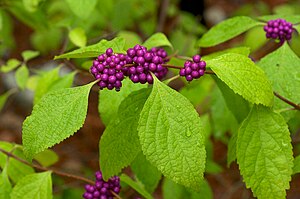American beautiful fruit
| American beautiful fruit | ||||||||||||
|---|---|---|---|---|---|---|---|---|---|---|---|---|

Fruits and leaves of the American beautiful fruit ( Callicarpa americana ) |
||||||||||||
| Systematics | ||||||||||||
|
||||||||||||
| Scientific name | ||||||||||||
| Callicarpa americana | ||||||||||||
| L. |
The American beautiful fruit ( Callicarpa americana ), also known as the American love pearl bush, is a species of the mint family (Lamiaceae), which belongs to the mint-like family (Lamiales).
features
The American beautiful fruit is a deciduous shrub that reaches heights of growth of 1.8 to 2.4 meters. The opposite , simple, ovate-elongated leaves are glandular and tomentose on the underside and hairy on the top. They are 7 to 20 cm long and toothed .
Dense, zymous inflorescences are formed in the leaf axils . They appear from May to July. The 3 mm long, almost sessile, hermaphrodite, radially symmetrical flowers are four-fold and glabrous. The four petals are light blue. There is only one circle with four stamens .
The diameter of the round, purple, berry-shaped drupes is about 0.6 cm.
Occurrence
The American beautiful fruit is found in the central and southeastern United States and from the Bahamas to Cuba.
use
In the American southern states Callicarpa americana is one of the plants traditionally used against mosquito bites, tick and ant bites. The leaves are rubbed onto the skin. Even horses were rubbed with leaves of the American beautiful fruit to protect them from horseflies.
Charles T. Bryson, botanist at the University of Mississippi, and colleagues analyzed the substances that deter insects in 2006. As a result, the plant contains three substances called Callicarpenal, Intermedeol and Spathulenol, which are responsible for the resistance to insects. Each of these substances repels mosquitoes, say the scientists. Callicarpenal, the researchers have applied for a patent. As soon as patent protection has been achieved, a biological insect repellent will be developed from this.
The researchers do not yet know for what purpose the American beautiful fruit uses the substances. Presumably they also serve to ward off insect attacks.
The fleshy, juicy, sweet fruits can be eaten.
literature
- Jost Fitschen : Woody flora . Quelle and Meyer Verlag GmbH & Co., Wiebelsheim 2002
Individual evidence
- ↑ Rafaël Govaerts (ed.): Callicarpa americana. In: World Checklist of Selected Plant Families (WCSP) - The Board of Trustees of the Royal Botanic Gardens, Kew . Retrieved January 21, 2018.
- ↑ Entry in Plants for a Future. (engl.)